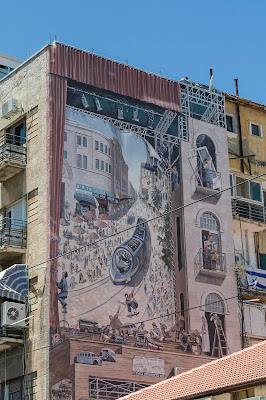All things must come to pass: there’s probably
none who know the weight of these words better than those working
archaeological excavations. However, with our focus so firmly fixed on the far
end of history, it is easy to forget that the same law holds true in our own
age. All things must come to an end, and so too has this excavation season. This
is not simply a sad time because all your friends have left, but because you
shared a special experience with them in excavating an ancient synagogue. An
excavation is a very unusual kind of project to be a part of and it is
sometimes described as being a mix between a summer camp and a prison camp.
People volunteer to do hard manual labour and have a grand old time doing it.
For some of them it still feels mostly like a summer camp, while others still
consider it closer to a prison camp. However, I haven’t talked to a single
person who hasn’t enjoyed being part of the project for one reason or another
or made at least one new friend during their stay.
You get attached to a great many things during
a season. The beautiful sunrises over the Golan are an obvious one, as is the
night view of Tiberias from the lake. But you also get attached to the typical
dig humour, the bad jokes, and the “back to work!” calls. Even the sounds of
the various accents become comfortably familiar. You get used to the southern
drawls from the US, the blends of soft and sharp from Switzerland and the
cooled staccato from Finland. We may all
communicate in English, but this is by no means the ‘unified language’ of the
dig. That is made up by the universal, intrinsic understanding we have of what
we mean when we speak to one another. It makes us understand phrases such as “it’s
that thing up on the thingy” perfectly. To me, it is this kind of thing that
makes the excavation is a living entity, composed from the many facets that
make the Kinneret Regional Project so unique. From the camp manager that can
move mountains through sheer willpower, to the wacky stories shared during
breakfast, to songs like The Ballad of Michael Dustpanhands, to smoking hookah
on the steps outside the Damascus gate during the free weekend. At the very
heart of all these memories stands the synagogue of Horvat Kur. It is the core
around which everything revolves. It is our heart of stone. I will miss the
walls that we have excavated over the years just as much as all those people
who have helped us excavate it.
Yet, there is a shimmer of light on the horizon.
We have had a wonderful season with truly amazing finds and we are far from
done. We came from our homes spread across the globe to our home on the shore
of Lake Kinneret. Now, we are all ready to go home and return to the normal
world, where our friends and family await. Even though we will be all at peace
again and able to rest our weary bodies, we know that one day perhaps this home
of ours on the shore of the lake will call to us once more. It will ask us to
come home to it and explore the history of Horvat Kur even further. Ultimately
this is the greatest thing about being at home everywhere: in the end you are
always homeward bound.
Dear fellow people of Horvat Kur. It has once
again been a tremendous honour and a great pleasure to spend these weeks
together with you. Thank you for all the laughs and the good times spent at the
site, the breakfast tent, the lab, the lakeshore and on the stairs. Know that
with each of you leaving to go back home, chips of my heart have fallen off to
make room for you all inside it. For some of you, I’ve even began expanding the
accommodations. May you all find beautiful lamp fragments on the road of life
and I hope that one day our paths will cross again. When we do, you should lose
track of your timing and have a drink beside me. I’ll be buying.
Signing off







